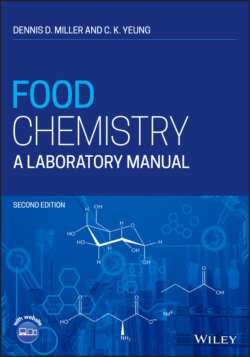Читать книгу Food Chemistry - Dennis D. Miller - Страница 45
2.6 Problem Set
ОглавлениеNote: These problems are designed to help you review concepts from introductory chemistry. Consult your introductory chemistry textbook for review.
1 Calculate the volume (at 25 °C and 1 atmosphere) of available CO2 contained in 0.34 g NaHCO3.
2 Explain why leavening rates differ between leavening acids.
3 The bicarbonate ion contains a proton and yet bicarbonate acts as a base in most leavening systems. Explain why this is so.
4 Why are double‐acting baking powders more effective in many baking applications than single‐acting baking powders?
5 The recipe for a large batch of pancake batter specifies 1 pound of baking soda and MCP as the leaving acid. How much MCP should be used?
6 Vinegar contains about 5% acetic acid (wt/vol). Calculate the normality of vinegar. What volume of vinegar would be required to neutralize 100 ml of 0.1 N sodium hydroxide?
7 You are baking a batch of biscuits and are out of baking powder. You decide to improvise and use vinegar and baking soda. You decide to add 2 teaspoons of baking soda to your dough. What volume of vinegar will you use? Assume that 1 mole of acetic acid will neutralize 1 mole of baking soda. One teaspoon of baking soda weighs 5 g.
8 The published neutralizing value of monocalcium phosphate monohydrate (MCP) is 80. Calculate the expected NV of monocalcium phosphate monohydrate based on stoichiometric relationships. Assume that the MCP is behaving as a monoprotic acid in this system. Does your result agree with the measured value of 80? If not, give a possible explanation. Note: To solve this problem, you will need to write balanced equations for the reactions between MCP and sodium bicarbonate (one with MCP acting as a monoprotic acid and the other with MCP acting as a diprotic acid).
9 What volume of CO2 would be produced from the complete neutralization of 5 g sodium bicarbonate at 80 °C?
10 Draw the structure of potassium acid tartrate. Write an equation to show why it is a leavening acid.
11 What is the main leavening acid in cultured buttermilk? Draw its structure.
12 What is the main leavening acid in lemon juice? Draw its structure.
13 Explain how glucono‐delta‐lactone can act as a leavening acid.
14 What is the minimum percentage of sodium bicarbonate in baking powder necessary to yield 12 g of CO2 per 100 g of powder? (Assume that all of the bicarbonate is converted to CO2 and H2O.)
15 What volume of 1.0 molar sulfuric acid would be required to neutralize 100 ml of 1.0 molar sodium hydroxide?
